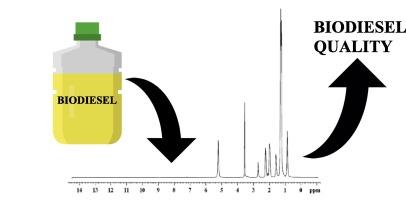Nuclear magnetic resonance (NMR) applications in biodiesel characterization and quality – A review
IF 4.9
2区 化学
Q1 CHEMISTRY, ANALYTICAL
引用次数: 0
Abstract
This manuscript highlights the role of nuclear magnetic resonance (NMR) in assessing the quality and purity of biodiesel. NMR has proven to be an indispensable tool for biodiesel characterization, allowing for precise identification of key physicochemical properties such as methyl ester content, oxidative stability, free fatty acids, and glycerin residues. The ability of 1H NMR to detect impurities, adulterants, and structural changes during production and storage ensures compliance with international standards like ASTM D6751 and EN 14214, which are essential for maintaining biodiesel quality and performance. The study comprehensively compares the application of NMR in analyzing biodiesel from various feedstocks, including vegetable oils, animal fats, and waste oils. NMR’s capacity to discriminate biodiesel sources through specific chemical shifts, such as the methoxy group at 3.6 ppm, and identify contaminants, like water and residual catalysts, highlights its superiority over other analytical techniques like gas chromatography (GC) and Fourier-transform infrared spectroscopy (FTIR). Additionally, the manuscript underscores the importance of NMR in optimizing production processes by evaluating conversion efficiency and identifying by-products. The key contributions of this study lie in its detailed comparison of biodiesel from different feedstocks and its focus on the role of impurities and additives in affecting biodiesel quality. This work confirms NMR’s effectiveness as a reliable, non-destructive tool for ensuring biodiesel purity, making it an essential technique in advancing biodiesel production, improving process efficiency, and promoting the use of sustainable biofuels.

核磁共振 (NMR) 在生物柴油表征和质量中的应用 - 综述
本手稿强调了核磁共振 (NMR) 在评估生物柴油质量和纯度方面的作用。事实证明,核磁共振是生物柴油表征不可或缺的工具,可精确鉴定关键理化性质,如甲酯含量、氧化稳定性、游离脂肪酸和甘油残留。1H NMR 能够检测生产和储存过程中的杂质、掺杂物和结构变化,确保符合 ASTM D6751 和 EN 14214 等国际标准,这对保持生物柴油的质量和性能至关重要。该研究全面比较了核磁共振在分析来自各种原料(包括植物油、动物脂肪和废油)的生物柴油中的应用。核磁共振能够通过特定的化学位移(如 3.6 ppm 的甲氧基)来鉴别生物柴油的来源,并识别污染物(如水和残留催化剂),这凸显了核磁共振比气相色谱法 (GC) 和傅立叶变换红外光谱法 (FTIR) 等其他分析技术的优越性。此外,手稿还强调了核磁共振在通过评估转化效率和识别副产品来优化生产过程方面的重要性。本研究的主要贡献在于详细比较了来自不同原料的生物柴油,并重点研究了杂质和添加剂对生物柴油质量的影响。这项工作证实了核磁共振作为确保生物柴油纯度的可靠、非破坏性工具的有效性,使其成为促进生物柴油生产、提高工艺效率和推广使用可持续生物燃料的重要技术。
本文章由计算机程序翻译,如有差异,请以英文原文为准。
求助全文
约1分钟内获得全文
求助全文
来源期刊

Microchemical Journal
化学-分析化学
CiteScore
8.70
自引率
8.30%
发文量
1131
审稿时长
1.9 months
期刊介绍:
The Microchemical Journal is a peer reviewed journal devoted to all aspects and phases of analytical chemistry and chemical analysis. The Microchemical Journal publishes articles which are at the forefront of modern analytical chemistry and cover innovations in the techniques to the finest possible limits. This includes fundamental aspects, instrumentation, new developments, innovative and novel methods and applications including environmental and clinical field.
Traditional classical analytical methods such as spectrophotometry and titrimetry as well as established instrumentation methods such as flame and graphite furnace atomic absorption spectrometry, gas chromatography, and modified glassy or carbon electrode electrochemical methods will be considered, provided they show significant improvements and novelty compared to the established methods.
 求助内容:
求助内容: 应助结果提醒方式:
应助结果提醒方式:


